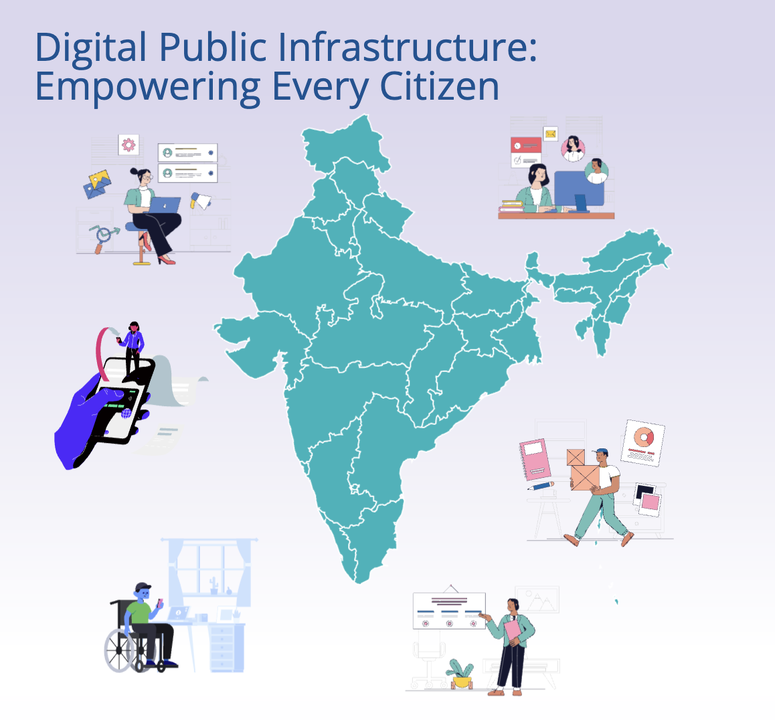Digital Public Infrastructure: Empowering Every Citizen
DPI includes components like internet connectivity, digital identity systems, online payment platforms, and open data portals
 Prabhu Elangovan, Assistant Vice President - Protean eGov Technologies
Prabhu Elangovan, Assistant Vice President - Protean eGov Technologies

FinTech BizNews Service
Mumbai, February 4, 2024: In the LinkedIn Blog #PrabhuTalks, Prabhu Elangovan, Assistant Vice President - Protean eGov Technologies, has highlights the significance of Digital Public Infrastructure (DPI) in empowering the common man by providing access to government services, financial inclusion, education, healthcare, and entrepreneurship opportunities. Prabhu Elangovan has shared notable observations on the DPI:
Digital public infrastructure encompasses the technological framework and resources provided by the government to facilitate digital services and connectivity for its citizens. It includes components like internet connectivity, digital identity systems, online payment platforms, and open data portals. This infrastructure is crucial for a country as it enhances access to essential services, promotes economic growth through digital innovation, fosters inclusivity by bridging the digital divide, strengthens governance and transparency, and enables efficient delivery of public services to citizens.
✳ The blog [ https://lnkd.in/d32i-Xk9 ] highlights the significance of Digital Public Infrastructure (DPI) in empowering the common man by providing access to government services, financial inclusion, education, healthcare, and entrepreneurship opportunities. Through digital platforms and services, DPI enhances convenience, connectivity, and accessibility, ultimately improving the quality of life for individuals across various domains. Overall, hashtag#DPI serves as a catalyst for inclusive hashtag#growth, hashtag#innovation, and hashtag#socioeconomic development in society.
hashtag#PrabhuTalks hashtag#digitalindia
These ministries, along with various other government agencies and departments, collaborate to build and maintain Digital Public Infrastructure (DPI) in India, enabling inclusive and sustainable digital development across the country.
Unlocking the Significance of Digital Public Infrastructure: Common Man's Utilization
- Access to Government Services: DPI facilitates access to various government services online, such as applying for documents (e.g., Aadhaar, passports), paying taxes, and accessing welfare schemes, making it convenient for the common man to interact with government agencies from anywhere.
- Financial Inclusion: Through digital payment platforms like UPI and Aadhaar-enabled payment systems, DPI enables easy and secure transactions, including payments for goods and services, money transfers, and bill payments, empowering individuals, especially those in remote areas, to participate in the formal economy.
- Digital Identity and Authentication: With Aadhaar, individuals can easily verify their identity online for various purposes, such as opening bank accounts, applying for loans, and accessing government benefits, streamlining processes and reducing paperwork.
- Access to Information and Education: Digital platforms and portals provide access to a wealth of information and educational resources, including online courses, e-books, and educational videos, enabling lifelong learning and skill development for the common man.
- Entrepreneurship and Employment Opportunities: DPI fosters entrepreneurship by providing access to digital platforms for e-commerce, online marketplaces, and digital marketing, allowing individuals to start and grow businesses with minimal investment. It also facilitates job search and recruitment through online job portals and professional networking platforms.
- Healthcare Services: Digital platforms enable access to healthcare services, including telemedicine consultations, appointment bookings, and access to medical records, improving healthcare accessibility and outcomes for the common man, especially in rural and underserved areas.
- Ease of Communication and Social Interaction: DPI facilitates communication and social interaction through various digital channels, including social media platforms, messaging apps, and video conferencing tools, connecting individuals with friends, family, and communities globally.
- Safety and Security: DPI incorporates measures for cybersecurity and data protection to ensure the safety and security of digital transactions and personal information, instilling trust and confidence among users.
Overall, DPI enhances the quality of life for the common man by providing access to essential services, enabling financial inclusion, fostering entrepreneurship and employment opportunities, facilitating access to information and education, improving healthcare accessibility, facilitating communication and social interaction, and ensuring safety and security in the digital realm.
Key Ministries, along with various other government agencies and departments:
Several organizations are involved in building and maintaining India's Digital Public Infrastructure (DPI), facilitating the nation's digital transformation. Here are some key organizations:
- Ministry of Electronics and Information Technology (MeitY): MeitY is the nodal ministry responsible for formulating policies and implementing programs related to information technology, electronics, and digital governance in India. It oversees initiatives aimed at building digital infrastructure, promoting cybersecurity, and fostering innovation in the IT sector.a) Unique Identification Authority of India (UIDAI): UIDAI is responsible for implementing Aadhaar, India's biometric-based digital identity system. UIDAI manages the Aadhaar database, issues Aadhaar numbers, and provides authentication and eKYC services, facilitating access to various government and private services.b) Digital India Corporation (DIC): Formerly known as the National e-Governance Division (NeGD), DIC is responsible for implementing various initiatives under the Digital India program. It works towards promoting digital literacy, enabling digital infrastructure development, and facilitating e-governance services across the country.
- Ministry of Communications: The Ministry of Communications, which includes the Department of Telecommunications (DoT) and the Department of Posts, plays a crucial role in expanding digital infrastructure, including internet connectivity, broadband networks, and postal services, to ensure widespread access to digital services.It plays a crucial role in expanding digital infrastructure, including internet connectivity and mobile networks, to ensure widespread access to digital services.
- Ministry of Finance (MoF): MoF oversees financial policies and regulations in India, including those related to taxation, budgeting, and economic development. It collaborates with other government agencies and stakeholders to promote digital payments, financial inclusion, and economic growth through digital infrastructure development.a) Goods and Services Tax Network (GSTN): GSTN is the IT backbone of the Goods and Services Tax (GST) regime in India. It manages the technology infrastructure for GST compliance, including registration, return filing, and tax payments, enabling seamless tax administration and compliance for businesses.b) Reserve Bank of India (RBI): RBI plays a regulatory role in the development of digital infrastructure for financial services. It sets policies and regulations governing digital payments, banking, and financial inclusion, ensuring the stability and security of the financial system.c) National Payments Corporation of India (NPCI): NPCI is a key player in developing and operating digital payment systems in India, including UPI (Unified Payments Interface), IMPS (Immediate Payment Service), and RuPay. NPCI plays a crucial role in promoting financial inclusion and driving digital transactions across the country.
- Ministry of Rural Development: The Ministry of Rural Development implements various initiatives aimed at enhancing digital infrastructure and connectivity in rural areas, including the BharatNet project, which aims to provide high-speed internet access to rural and remote areas across the country.
- Ministry of Home Affairs: The Ministry of Home Affairs is involved in ensuring cybersecurity and data protection to safeguard digital infrastructure and citizen information. It collaborates with other ministries and agencies to develop policies and strategies to mitigate cyber threats and enhance the security of digital services.
- Ministry of Health and Family Welfare: The Ministry of Health and Family Welfare oversees initiatives related to digital healthcare infrastructure, including telemedicine, electronic health records, and health information systems, to improve healthcare accessibility and delivery across the country.
- Ministry of Urban Development: The Ministry of Urban Development is responsible for urban infrastructure development, including digital infrastructure such as smart cities, digital governance platforms, and e-municipal services, to enhance urban living standards and efficiency.
India Stack stands as a transformative framework that has played a pivotal role in building a robust Digital Public Infrastructure (DPI) in India. Comprising a set of open APIs (Application Programming Interfaces) and digital platforms, India Stack has revolutionized service delivery, financial inclusion, and citizen empowerment. Let's delve into its significant contributions:
- Aadhaar Authentication and eKYC: Aadhaar, a foundational component of India Stack, provides a unique digital identity to residents of India. Aadhaar Authentication and eKYC (Know Your Customer) services enable instant and paperless verification of individuals' identities, facilitating seamless access to a wide array of services, including banking, telecom, and government schemes. This has streamlined onboarding processes, reduced paperwork, and enhanced efficiency across sectors, contributing to the development of a robust DPI.
- UPI (Unified Payments Interface): UPI, another flagship initiative of India Stack, has revolutionized the digital payments landscape in India. This real-time payment system enables individuals to transfer funds instantly between bank accounts using their smartphones. UPI has democratized digital payments, catalyzed financial inclusion, and spurred innovation in the fintech ecosystem. Its widespread adoption has accelerated the digitization of transactions, reduced cash dependency, and fostered economic growth, thereby strengthening the DPI.
- Digital Locker: The Digital Locker, an integral component of India Stack, provides citizens with a secure digital repository to store and access their documents and certificates electronically. By digitizing documents such as educational certificates, property records, and government-issued IDs, Digital Locker enhances accessibility, eliminates the need for physical copies, and mitigates the risk of document loss or tampering. This empowers citizens with greater control over their personal data and simplifies interactions with government and private organizations, bolstering the resilience of the DPI.
- eSign (Electronic Signature): eSign, a legally valid electronic signature service, enables individuals to sign documents digitally using Aadhaar authentication. This eliminates the need for physical signatures, expedites document processing, and enhances the security and authenticity of transactions. eSign facilitates paperless workflows across sectors, including banking, insurance, and government services, fostering efficiency, transparency, and trust in digital interactions, thereby fortifying the DPI.
- GSTN (Goods and Services Tax Network): India Stack integrates with GSTN, the technology backbone of the Goods and Services Tax (GST) regime, to facilitate seamless tax compliance and administration. Through APIs and digital interfaces, businesses can file GST returns, make payments, and access tax-related services online. This digitization of tax processes enhances compliance, minimizes administrative burden, and promotes ease of doing business, contributing to the resilience and effectiveness of the DPI.
In essence, India Stack has been instrumental in laying the foundation for a robust Digital Public Infrastructure (DPI) in India. By democratizing access to digital services, enabling secure and seamless transactions, and fostering innovation and efficiency across sectors, India Stack has accelerated the nation's digital transformation journey and positioned India as a global leader in digital governance and inclusive growth.

